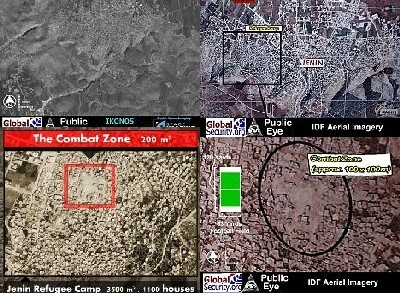The Electronic Intifada 28 August 2002
The Israeli Ministry of Foreign Affairs website is attempting to minimize the scale of the IDF’s destruction of the Jenin refugee camp through a Flash presentation.
According to the MFA:
“Palestinian claims on the extent of damage in Jenin do not pass the test of reality”.

MFA website
However, reliable data gathered from international organisations and aerial imagery contradict the figures presented in the MFA’s flash presentation.
The Support Group, formed in April 2002 under the aegis of the Local Aid Coordination Committee, which is co-chaired by the World Bank, UNSCO and the Norwegian Representative Office to assist the Palestinian Authority and local government efforts to cope with the emergency resulting from military incursions, cites a different number of homes destroyed by the Israeli army.

From top left to right down: (1) Ikonos browse imagery of the town of Jenin as of December 2001; (2) IDF aerial imagery of the town of Jenin, before operation ‘Defensive Shield’; (3) Israeli Ministry of Foreign Affairs Flash Presentation; (4) The diagram of a U.S. Football field on the left, helps to place the size of the damaged area in perspective. IDF aerial imagery of the Jenin Refugee Camp as of 13 April, 2002. Images were taken from Globalsecurity.org.
A chart prepared by the Support Group, based on UNRWA figures on the number of houses and units in the Jenin camp, shows that 160 houses have been completely demolished and approximately 100 other houses were severely damaged, to the point that they must now be razed. Additionally, 300 houses are partially destroyed and in need of urgent repair.

Panorama destruction of Jenin refugee camp, based on video imagery
The chart also shows that the average size of a housing unit is 100 m2 and that each house consists of three units. The total number of houses in Jenin refugee camp requiring reconstruction is 267.

160 buildings, most multifamily dwellings, were completely destroyed (green) in Jenin and 100 houses damaged, which will be obliterated and an additionally, 300 houses are partially destroyed (red). Hawashin district, where more than 100 buildings were razed, is at the left side of the map.
Assuming a possible mathematical confusion in the measurement of the combat zone and the refugee camp, whereby 200 square meters (m2) were mistaken for meters squared (200m x 200m), then the combat zone would actually measure about 40,000 square meters, less than the area obtained from our original analysis.
Furthermore, the MFA’s flash presentation suggests that the destruction of ‘only’ 95 homes is not so bad. However, Jenin refugee camp was home to 14,000 Palestinian refugees, of whom, according to our calculations (see below) 2,640 have become homeless for the second time in their lives. These refugees have lost not only their homes, but also their relatives.

Jenin refugee children searching for their relatives.
Human Rights Watch researchers, who were investigating inside Jenin refugee camp from April 19 to April 28, counted a total of 140 completely destroyed buildings in the camp—many multi-family dwellings—of which more than one hundred were located in the completely razed area of the Hawashin district. According to Human Rights Watch:
‘the wholesale leveling of the entire district extended well beyond any conceivable purpose of gaining access to fighters, and was vastly disproportionate to the military objectives pursued.’Source: Jenin: IDF military operations, HRW, May 2002
Aside from the razed Hawashin district, Human Rights Watch counted over 200 houses which sustained major damage, most so serious as to render the homes uninhabitable. These assessments were based only on those houses where damage is externally visible.
At the time of Human Rights Watch’s research, no assessment had been made of how many houses had been damaged by the internal ‘mouseholing’ procedures the Israeli army used to transit from house to house in the camp by knocking holes
through walls.
Whether one accepts the official 200 m2 claimed by the MFA’s flash presentation or the more realistic 48,000 m2 obtained from our analysis and that of HRW, the disparity between the IDF’s claim and other observors is profound.
The Support Group puts the actual number of houses completely destroyed at 160 plus 100 houses that are so badly damaged that they need to be completely rebuild. With the average number of persons per house of 16.5 (3 families in each house, average number of 5.5 persons per family) there would be 1,567 homeless refugees (with the Israeli figure of 95 demolished homes) and 2,640 homeless refugees (according to our analysis).
Finally, destruction of property in occupied territories is forbidden under article 53 of the Fourth Geneva Convention. It constitutes collective punishment, a violation that is explicitly prohibited by article 33 of the Fourth Geneva Convention. It further constitutes extra-judicial punishment and arbitrary interference in home and property.
Related links:



